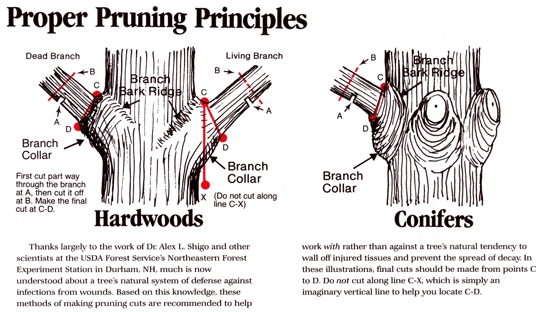Pruning
Pruning
Pruning, done correctly, can do much to enhance tree health and appearance. Done incorrectly, it can cause starvation, shock, an excess of new growth, hazardous limb attachments, ugliness and even the death of the tree.
Permits are required for pruning public trees.
Click here to see the permit page for more information
Reasons to prune include:
- Improving tree form: thinning tree canopy over-crowded with branches; cutting back branches that "protrude" beyond the natural outline of the tree, and eliminating double leaders.Improving tree health: removing dead, damaged, or diseased branches; removing rubbing branches; removing vigorous water sprouts and suckers.
- Functional purposes: "lifting" the lower "skirt" of the tree for clearance over streets, sidewalks, fences and/or roofs.
Pruning cuts should be made where a limb connects to a larger limb or the tree trunk. This allows the tree’s natural defense mechanisms to "wall off" injured tissue. The National Arbor Day Foundation, based on the research of Dr. Alex Shigo and other scientists for the USDA Forest Service, recommends the pruning methods illustrated here. In these illustrations, final cuts should be made from points C to D. Do not cut along line C-X, which is an imaginary vertical line to help you locate C-D.
Shortening a limb should be done by cutting back to a lateral branch that is at least 1/3 as large in diameter as the branch at the pruning cut. Make sure the lateral branch is headed in a desirable direction.
Topping (also called stubbing, hat-racking, lopping or heading back) is a common practice but is not in any way good for trees. It is pruning at its worst. Many people top trees to make trees smaller, not realizing that the resulting sprouts are much more numerous and faster growing than normal branches - a "panic" reaction of the tree. The trees will quickly re-grow (and out-grow) their previous size, but the branches are weakly attached, and tree health reduced by the energy put into the new growth.
Reduction of tree size is possible through correct pruning procedures. It is best accomplished by a trained Arborist. However, if you find yourself continuously pruning a tree because of size restrictions, you may want to evaluate whether that tree is the right one for your spot.
Topping is against city ordinance and may result in a penalty in addition to a fine in the amount of the damage and reduced value of the tree. In some cases, severely damaged trees will be required to be removed and replaced.








